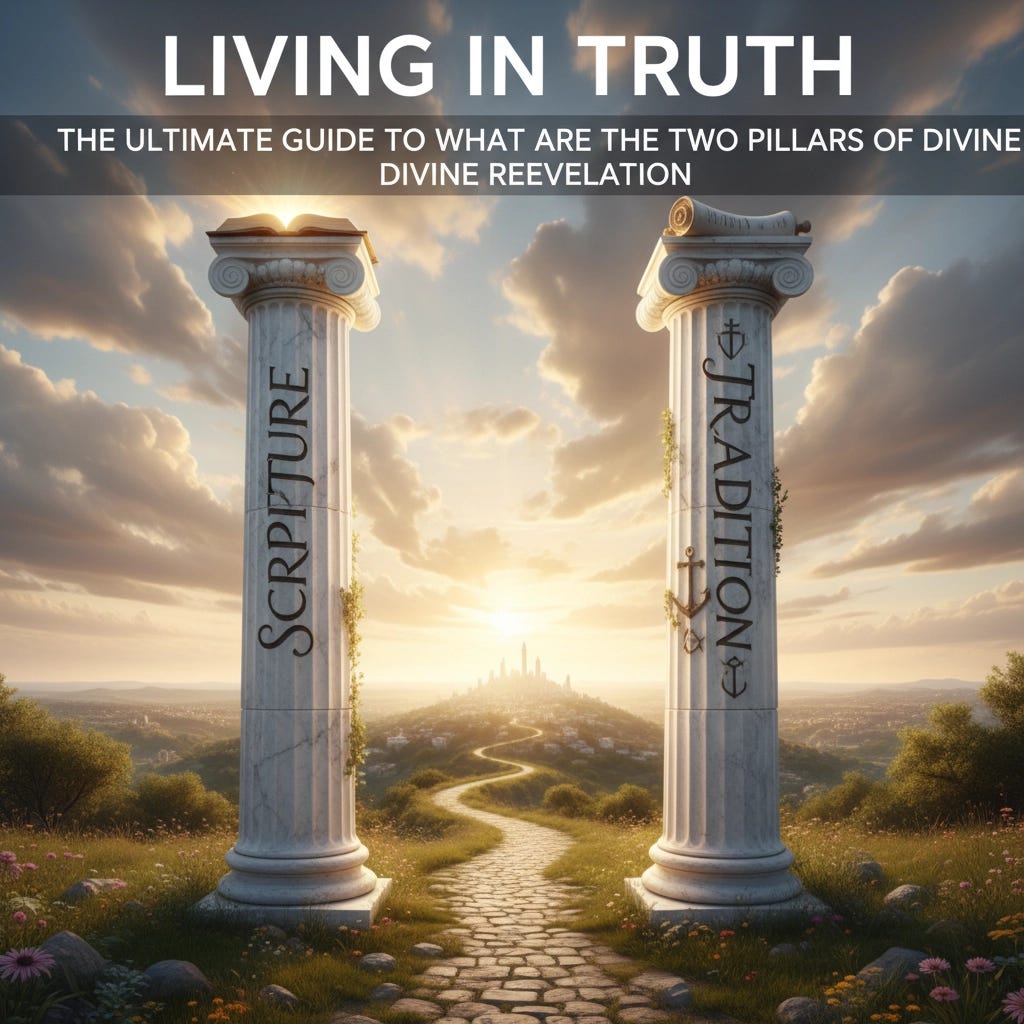Living in Truth
The Ultimate Guide to the Two Pillars of Divine Revelation
Truth stands under assault. In our age of relativism, where every opinion claims equal validity and moral certainty is dismissed as bigotry, the Church must return to its foundational understanding of how God reveals Himself to humanity. This is not academic theology: this is survival.
For two millennia, Christianity has weathered every storm through its unwavering commitment to divine revelation. From the Roman coliseums to Soviet gulags, from medieval plagues to modern persecution, believers have held fast to two unshakeable pillars that support the entire edifice of Christian faith.
These pillars are Sacred Scripture and Sacred Tradition. Together, they form what the Church calls the deposit of faith: the complete and irreducible body of God’s revelation to mankind.
The Foundation That Cannot Be Moved
Here’s what the cultural elites won’t tell you: Christianity isn’t built on shifting sand. While secular ideologies rise and fall with each generation’s whims, Christian truth rests on divine revelation that transcends human opinion.
Sacred Scripture and Sacred Tradition work as complementary witnesses to the same divine truth. They don’t compete: they confirm. They don’t contradict: they complete. This isn’t theological speculation. This is the bedrock reality that has sustained the Church through twenty centuries of attack.
Sacred Scripture represents the written Word of God, composed under the inspiration of the Holy Spirit. Every word carries divine authority. Every verse speaks with eternal weight.
Sacred Tradition encompasses the living transmission of God’s revelation: the oral teachings of Christ and the apostles, preserved and passed down through the Church’s continuous authority.
Sacred Scripture: The Written Witness
Scripture stands as Christianity’s non-negotiable foundation. When Jesus walked the earth, He quoted extensively from what we now call the Old Testament, treating every word as divinely authoritative. “It is written” settled every debate.
The 66 books of the Protestant Bible, or the 73 books recognized by the Catholic Church, didn’t emerge by accident. Divine providence guided their recognition, preservation, and compilation. These texts survived empires, outlasted persecutions, and speak with undiminished power today.
Consider the manuscript evidence. We possess over 5,800 Greek New Testament manuscripts: more than any other ancient text by an overwhelming margin. Homer’s Iliad, the second-best preserved work of antiquity, exists in fewer than 700 manuscripts. The textual foundation of Christianity stands unmatched in historical documentation.
But here’s what matters more than academic credentials: Scripture transforms lives. It has converted emperors and slaves, philosophers and peasants. It speaks across cultures, languages, and centuries with supernatural consistency.
The authority of Scripture doesn’t depend on human approval. It carries inherent divine authority because God authored it through human instruments. This isn’t circular reasoning: it’s recognition of objective reality.
Sacred Tradition: The Living Voice
Sacred Tradition flows from the same divine source as Scripture, but through a different channel. When Christ commissioned His apostles, He didn’t hand them a completed Bible. He gave them His teachings: orally transmitted, Spirit-empowered truth that they would proclaim to the world.
The word “tradition” comes from the Latin tradere, meaning “to hand down.” This isn’t human custom or cultural preference. This is divine revelation transmitted through the living voice of the Church.
Early Christians received the Gospel primarily through preaching, not reading. Most couldn’t read. They encountered Christ’s truth through apostolic proclamation, liturgical worship, and community practice. The Church existed before the New Testament was written, compiled, or canonized.
This presents a crucial point often misunderstood: Scripture itself emerged from Tradition. The Church, guided by Sacred Tradition, recognized which writings carried apostolic authority and deserved inclusion in the biblical canon. Without Tradition, we would have no reliable way to distinguish inspired Scripture from helpful but non-authoritative Christian writings.
Sacred Tradition includes:
The apostolic teachings not recorded in Scripture
The Church’s Spirit-guided interpretation of Scripture
The liturgical practices handed down from apostolic times
The theological insights developed through centuries of faithful reflection
How the Two Pillars Work Together
Here’s where modern Christianity often goes wrong: treating Scripture and Tradition as opponents rather than allies. Some denominations claim “Scripture alone” while simultaneously relying on traditional interpretations developed over centuries. Others elevate tradition to the point where it obscures scriptural clarity.
Both extremes miss the biblical reality. Scripture and Tradition function as two sides of the same coin: distinct but inseparable witnesses to divine revelation.
Scripture provides the written foundation. Its words carry final authority in matters of faith and practice. No tradition can contradict clear scriptural teaching without forfeiting its claim to divine origin.
Tradition provides the interpretive framework. It shows how the apostolic Church understood and applied scriptural truth. It preserves teachings that complement rather than compete with Scripture.
Consider the Trinity: Christianity’s central doctrine. While Scripture clearly teaches God’s triune nature, the specific theological language we use (”Trinity,” “hypostasis,” “consubstantial”) developed through centuries of Traditional reflection. The doctrine is biblical. The precise terminology is traditional. Both work together to preserve divine truth.
Living in Truth Today
This isn’t ancient history. The two pillars of divine revelation directly impact how Christians should live in our current cultural moment.
First, we must reject the false choice between Scripture and Tradition. Authentic Christianity embraces both. Scripture provides our ultimate authority. Tradition provides our interpretive guide. Together, they offer stability in an age of confusion.
Second, we must resist the temptation to update divine revelation for contemporary sensibilities. Both Scripture and Tradition speak with timeless authority. They judge culture: culture doesn’t judge them.
Third, we must recognize that living in truth requires both intellectual understanding and spiritual submission. Knowing about the two pillars isn’t enough. We must build our lives on their foundation.
The cultural chaos surrounding us makes sense when viewed through this lens. A society that rejects divine revelation inevitably creates its own moral confusion. When absolute truth becomes relative opinion, every voice claims equal authority and no voice carries ultimate weight.
Practical Steps for Building on Truth
1. Study Scripture systematically. Don’t just read favorite verses. Engage with the full biblical revelation. Use study tools that reflect traditional Christian interpretation while maintaining scriptural primacy.
2. Learn from Church history. Understand how faithful Christians throughout the centuries have interpreted and applied biblical truth. Don’t reinvent the theological wheel.
3. Test contemporary teachings against both pillars. Any teaching that contradicts clear scriptural truth or violates consistent Christian tradition deserves immediate suspicion.
4. Practice discernment in your media consumption. Secular voices often present false choices between “progressive” flexibility and “fundamentalist” rigidity. Authentic Christianity transcends these categories through its foundation in divine revelation.
5. Engage your local faith community. Truth isn’t merely intellectual: it’s communal. The Church preserves and transmits divine revelation through corporate worship, teaching, and fellowship.
The Stakes Are Eternal
This matters because truth matters. In a world drowning in relativism, the Church offers the only reliable anchor. Sacred Scripture and Sacred Tradition don’t merely provide religious information: they reveal the character and will of the living God.
Every generation faces the same choice: build on the rock of divine revelation or construct on the sand of human opinion. The foundations we choose determine not only our temporal stability but our eternal destiny.
The two pillars have supported Christian civilization for two millennia. They’ve outlasted empires, survived revolutions, and will continue standing long after today’s cultural movements fade into historical footnotes.
The question isn’t whether these pillars will endure. They will. The question is whether we’ll build our lives on their unshakeable foundation or continue drifting in the shifting currents of contemporary opinion.
Truth calls for decision. Divine revelation demands response. The two pillars of Sacred Scripture and Sacred Tradition stand ready to support those willing to build their lives on something greater than human wisdom.
The choice is yours. Choose truth. Choose stability. Choose the foundation that has never failed and never will.







